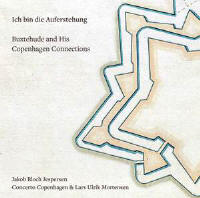Texte paru dans: / Appeared in: |
|
|
Outil de traduction ~ (Très approximatif) |
|
|
Reviewer: James
V. Maiello
The program
opens with Buxtehude’s solo cantata Ich bin die Auferstehung, as if to
provide a baseline against which to compare the composer’s predecessors. It
also serves as a fine introduction to the musicians. Jespersen by turns
effervescent and plaintive, creating distinct vocal colors to match the
Affekt of the music and text. Concerto Copenhagen is, as usual, in fine
form. The ensemble offers a taut reading of the score that is punctuated by
dazzling passagework and sensitively shaped lines. The organ in the
Trinitatis Church is an exceptional Italian instrument that dates from 1770
and which was restored and installed in the Copenhagen church in 2013. It is
perfect for this repertoire, and Mortensen’s continuo playing is intelligent
and stable. Erben’s Sonata sopra ut, re, mi, fa, sol, la follows, another
showpiece for the instrumentalists, whose nuanced playing sounds easy and
natural, even conversational throughout. Other highlights include Meder’s Gott hilf mir, one of three world premiere recordings on the album. Likely for a Vespers service, one can hear the gestures and musical vocabulary of Schütz, there is a dramatic quality to the music that both Jespersen and the ensemble exploit to full effect. Traversing a landscape that includes pyrotechnic virtuosity, anguished dissonance, and ominously tense motion, the piece and its performance are a tour de force. Nicholas Bruhns’s setting of Psalm 57, Mein Herz ist bereit, is a revelation, both in the inventiveness of the music and its interpretation by the performers. The virtuoso solo violin part is handled deftly by Frederik From, and Jespersen just exudes a sense of celestial joy; his voice is nimble and exuberant, wholly convincing. The concerted selections are interspersed with solo and chamber instrumental works, and among these, Mortensen delivers a standout performance of Weckmann’s Toccata in A Minor on a harpsichord. In short, this recording is a home run. The program is coherent, conceptually, and the performances are of the highest quality. This music is underrepresented on disc, and it has never sounded better. | |
|
|
|
|
Cliquez l'un ou l'autre
bouton pour découvrir bien d'autres critiques de CD |
|




